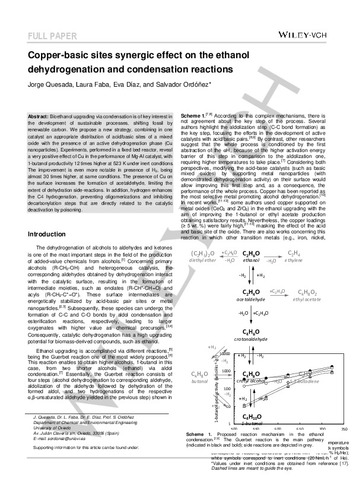Copper-Basic Sites Synergic Effect on the Ethanol Dehydrogenation and Condensation Reactions
Autor(es) y otros:
Fecha de publicación:
Versión del editor:
Citación:
Descripción física:
Resumen:
Bioethanol upgrading via condensation is of key interest in the development of sustainable processes, shifting fossil by renewable carbon. We propose a new strategy, combining in one catalyst an appropriate distribution of acid/basic sites of a mixed oxide with the presence of an active dehydrogenation phase (Cu nanoparticles). Experiments, performed in a fixed bed reactor, reveal a very positive effect of Cu in the performance of Mg-Al catalyst, with 1-butanol productivity 12 times higher at 523 K under inert conditions. The improvement is even more notable in presence of H2, being almost 30 times higher, at same conditions. The presence of Cu on the surface increases the formation of acetaldehyde, limiting the extent of dehydration side-reactions. In addition, hydrogen enhances the C4 hydrogenation, preventing oligomerizations and inhibiting decarbonylation steps that are directly related to the catalytic deactivation by poisoning.
Bioethanol upgrading via condensation is of key interest in the development of sustainable processes, shifting fossil by renewable carbon. We propose a new strategy, combining in one catalyst an appropriate distribution of acid/basic sites of a mixed oxide with the presence of an active dehydrogenation phase (Cu nanoparticles). Experiments, performed in a fixed bed reactor, reveal a very positive effect of Cu in the performance of Mg-Al catalyst, with 1-butanol productivity 12 times higher at 523 K under inert conditions. The improvement is even more notable in presence of H2, being almost 30 times higher, at same conditions. The presence of Cu on the surface increases the formation of acetaldehyde, limiting the extent of dehydration side-reactions. In addition, hydrogen enhances the C4 hydrogenation, preventing oligomerizations and inhibiting decarbonylation steps that are directly related to the catalytic deactivation by poisoning.
ISSN:
Patrocinado por:
Authors thank financial support for this work from the Ministry of Economy and Competitiveness of Spain (CTQ2014‐52956‐C3‐1‐R; CTQ2017‐89443‐C3‐2‐R). Jorge Quesada acknowledges the local Government of the Principality of Asturias for his PhD fellowship of the Severo Ochoa Program (PA‐14‐PF‐BP14‐105).
Colecciones
Ficheros en el ítem





